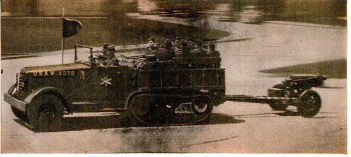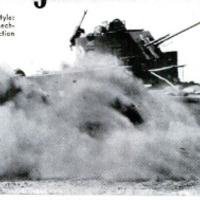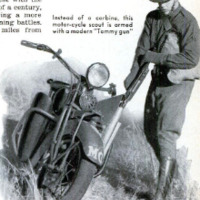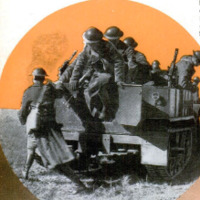-
Title (Dublin Core)
-
Grooming the iron cavalry
-
Article Title and/or Image Caption (Dublin Core)
-
Grooming the iron cavalry
-
extracted text (Extract Text)
-
OLD Bedford Forrest, the bewhiskered
Confederate cavalry leader, is said
to have remarked that the way to
win in war is to “git thar fustest with the
mostest.” After three quarters of a century,
no one has succeeded in evolving a more
generally useful receipt for winning battles.
At Fort Knox, twenty-odd miles from
Louisville, Ky., is stationed
the Army's most modern im-
plement for “gitting thar fust-
est with the mostest’—the
fast-moving and hard-hitting
mechanized force which is
designated officially the Sev-
enth Cavalry Brigade (Mech-
anized), but which the Army
prefers to call “the iron cav-
alry.”
In this supermodern caval-
ry the armored fighting ve-
hicle has taken the place of
the horse, commands snap
out of radio receivers instead
of ringing from brazen trum-
pets, the staccato machine
gun has superseded the
gleaming saber, and the
monkey wrench has taken
the place of the pitchfork.
But in spite of all these
changes and innovations, the
iron cavalry still is cavalry. The troopers
talk about engines and transmission systems
instead of about horses and saddles, but they
are trained to think fast and to act fast
and boldly, and so to carry on the great tra-
dition of American cavalry. |
The iron cavalry has the true cavalry |
cpirit, and it is armed, equipped, and trained
to do the traditional work of cavalry in war
—to carry out distant scouting missions, to
seize critical positions and hold them until |
the infantry has time to come up, to guard |
the army's flanks, to attack the enemy's
flanks and go swinging around them to raid |
his communications and destroy his supply |
depots, to pursue a beaten enemy. When
conditions of ground and weather are fa- |
vorable for its use, the Mechanized Brigade
is best suited to do many of these things,
because it can go farther faster, and hit
harder when it gets there, than can horse
cavalry. |
The Mechanized Brigade consists of a
brigade headquarters troop, two fully mech- |
anized regiments of cavalry, a battalion of
field artillery which has four motor-drawn
firing batteries each of four 75-millimeter
howitzers, an ordnance maintenance com-
pany for the fighting vehicles and a quarter-
master maintenance company for the trucks
and other vehicles, a signal detachment for
radio communication, a medical troop, and
a squadron of observation aviation. Its
present authorized strength is about 2,000
men, but it is hoped to double its strength
both in men and fighting vehicles.
THE backbone of the mechanized force's
fighting power is its armada of 112 com-
bat cars—two two-troop squadrons of them
in each of the cavalry regiments.
Cavalry combat cars are light tanks with’
full track-laying mechanism. They have the |
same engineering features which make our
infantry light tanks the world’s
best—airplane-type, air-cooled
engines which are more power-
ful than the engines of any other
country’s light tanks (see page
93), dependable transmission
and drive, and long-wearing tracks of rub-
bar composition set In steel blacks which
nave proved that they cun sand up under
ven the Intense heat generated by the tric.
ton of long, fast marches over sun-baked
southern hill roads. A few of the combat
Carn have Diewl engines.
‘Weighing nine and a halt tons, the com-
bat cara-—the troopers call them “hell bug.
es—aro couple of ton lighter than the
Infantry light tanks, and they are faster and
more maneuverable, Their top road spoed ia
better than ity. ve miles an hour, and they
can “cruise” at forty-five miles’ for long
Atretchen without unendurable. strain on
either. machines or crews. Cross-country,
heir top Apeed in considerably In excem of
twenty miles an hour over average ground,
and ther obstacle’ climbing Is spectacular.
Tocause of their ightar WelghL, their Armor
n't 50 thick ap Chat of the infantry tank.
The fron cavalry in willing to sacrifice some
deren of protection to get more speed.
Knother feature in which the combat car
afters trom the infantry tank 1 that it hax
one turret instead of two, and that Its guna
may ir in any direction. Tho crow consists
of Tour men. and the armament of one 50
Caliber and three 30 caliber machine guns
one of the latter In an antiaircraft mount.
Ech car also carries & Thompaon subma.
chine gun for close-quarters ighting, and
each crew man ia armed with & 45 caliber
automatic piatol. This heavy armament
ivan the combat cars tremendous fre pow-
They also may bo sed an shock weapons.
They won't be wasted In an attack on an
enemy's carerully prepared main potion,
but when the right opportunity for thelr
une arrives their Chundoring, lurching ad-
ance in ireapitting waves will be the ma
Chinie-ugo version of tho boot. Lo-boot charge
of yelling, saber-brandisning troopers.
In addition to its two squadrons of com-
bat cars, each of the mechanized cavalry
regiments has a reconnaissance troop and
a machine-gun troop.
The job of the reconnaissance troop is
scouting—especially long-distance scouting.
One of the regiments is equipped with scout
cars for this purpose, and the other with ar-
mored cars. The scout car is a fast, four-
wheel drive vehicle with high sides of light
armor. It carries a crew of from six to eight,
and its armament consists of three machine
guns mounted on a rail running entirely
around the car's top, giving the gunners an
all-around field of fire. The armored car is a
six-wheel, rear-drive vehicle closed in over
the top by a turret.
The business of the machine-gun troop is
to cover the advance of the combat cars
with their fire, and to give the iron cavalry
increased defensive power when it is neces-
sary for it to hold a position against an at-
tack. The machine gunners do most of their
fighting on the ground, but they ride to the
scene of action—the troop of one regiment
in scout cars, and the troop of the other in
half-track personnel carriers. The latter are
light trucks with the rear wheels replaced
by a track-laying mechanism.
ANOTHER distinctive type of combat ve-
hicle used by the Mechanized Brigade
is the mortar mount, a specially built four-
wheel armored truck carrying a smoke
‘mortar which its crew can dismount and set
up to lay down a smoke screen to cover
the advance or withdrawal of the brigade.
Motor cycles are used for various pur-
poses, their riders being armed with rifles or
with the submachine guns which the troop-
ers call “Tommy guns.”
To keep up with an outfit which can move
as fast and as far
as the iron cavalry, artillery must be motor-
ized. The battalion attached to the brigade
carries its gun crews in half-track person-
nel carriers of the same type as is used by
the machine-gun troops, and tows its 75-mil-
limeter howitzers behind them. These how-
itzers have a range of five and a half miles
—only about two thirds of the range of the
75-millimeter guns which they have re-
placed for cavalry use, but their high-angle,
lobbing type of fire and quick-aiming char-
acteristics make them decidedly useful to
the Mechanized Brigade.
Accompanying the fighting vehicles is the
train—big motor trucks loaded with drums
of gasoline, ammunition, and food; trucks
which are fast-moving machine shops; mo-
bile kitchens which cook as they roll. When
the full brigade is marching on a single
road its column stretches twenty miles from
head to tail.
Ahead of and above (he dust-sireaked
gray-green combat vehicles and trucks fly
the planes of the observation squadron. In
war their most important mission would be
to obtain and report information about the
enemy. On peacetime marches their main
job is to watch the long column for gaps,
and to report them by radio. The com-
mander of the iron cavalry, Brig. Gen. Adna
R. Chaffee—he is one of the Army’s most
brilliant cavalry officers and in his younger
days was one of its top competitive riders—
often controls the march from the air.
In an all-motorized, all-mechanized force
equipped with close to 600 vehicles, many of
them of exceptionally complicated character,
maintenance becomes a major problem.
~~ when lhe brigade 1s on Lhe move, each
troop is followed by its maintenance truck,
whose crew makes any roadside repairs it |
can handle. Regimental maintenance trucks
follow each regiment, and their crews take
care of more serious breakdowns. At the tail
of the column roll the trucks of the ordnance
maintenance company—trucks loaded with
spare parts and even spare engines, ma- |
chine-shop trucks, a generator truck which
provides electric lights for the field machine |
shop which is set up each evening in a big, |
square tent. Wreckers tow disabled vehicles |
to the night's bivouac, and the rule is that |
the cripples must be ready to roll when the
brigade marches in the morning. On a
march last year the maintenance companies
handled eleven major repair jobs in one
night, putting in 263 man labor hours doing |
it. At the end of the 700-mile trek the
brigade had all but two of its combat cars
and all its other vehicles except one half-
track in condition to take part in a stren-
uous tactical exercise.
Thirty-five miles is a full day's march for
horse cavalry. Fifty miles is a forced march.
Returning from a Civil War raid into Penn-
sylvania, Jeb Stuart's Confederate troopers
won lasting fame by riding from Chambers-
burg to White's Ford on the Potomac,
eighty-four miles, in twenty-four hours—one
of the great cavalry marches of history.
A hundred and fifty miles is a normal
day's march for the Mechanized Brigade.
Marching from Fort Knox to Plattsburg
last summer, it did 1,000 miles in six days.
On one occasion it marched 330 miles in a
little over twenty-four hours. These marches
weren't made under war conditions, of
course, but the iron cavalry moves fast—and
it can hit hard when it gets there.
The younger soldiers of the Mechanized
Brigade have served only in the iron cavalry.
They were attracted to it through their in-
terest in automobile mechanics and by the
fact that it is something brand new. The
brigade has no difficulty in filling its ranks
with high-grade recruits.
Nearly all the officers and many of the
noncommissioned officers are former horse
cavalrymen. Some of them I talked with ad-
mitted that they missed the horses, but all
of them were keenly interested in their new
jobs. An old top sergeant, with a lot of
service stripes on his sleeve, said: “When
you first come to the Mechanized Brigade
from a horse regiment, everything seems
strange to you. And then you begin to
realize that, after all, the Mechanized Bri-
gade isn't so very different from any other
cavalry outfit—that you're really doing the
same things for the same reasons, only
you're doing them in new ways. Cavalry is
cavalry, whether you're riding a horse or
driving a hell buggy.”
-
Contributor (Dublin Core)
-
Arthur A. Stuart (article writer)
-
Language (Dublin Core)
-
eng
-
Date Issued (Dublin Core)
-
1940-09
-
pages (Bibliographic Ontology)
-
99-101, 222-223
-
Rights (Dublin Core)
-
Public domain
-
Archived by (Dublin Core)
-
Sami Akbiyik
-
Marco Bortolami (editor)
 Popular Science Monthly, v. 137, n. 3, 1940
Popular Science Monthly, v. 137, n. 3, 1940
 Popular Science Monthly, v. 137, n. 3, 1940
Popular Science Monthly, v. 137, n. 3, 1940










